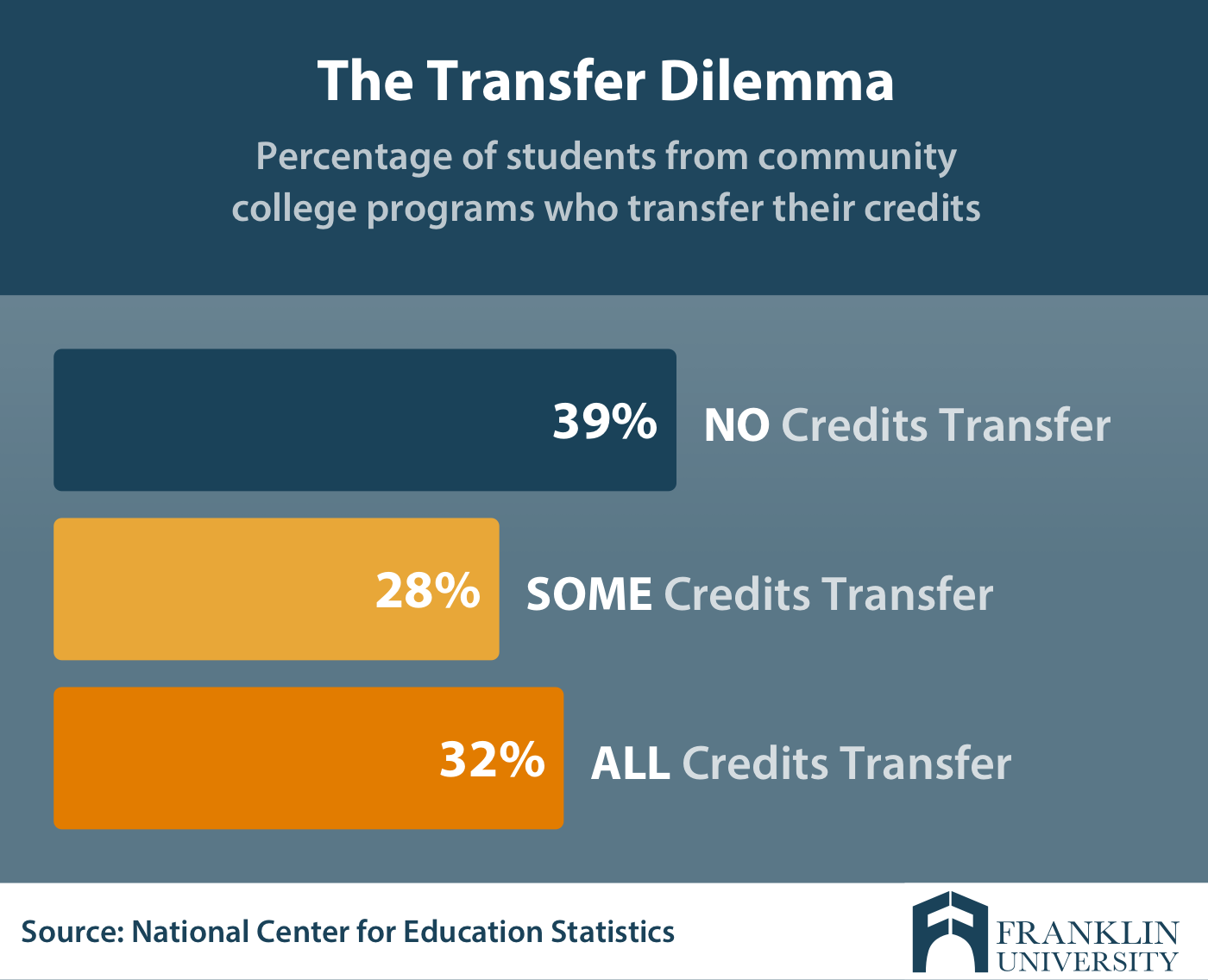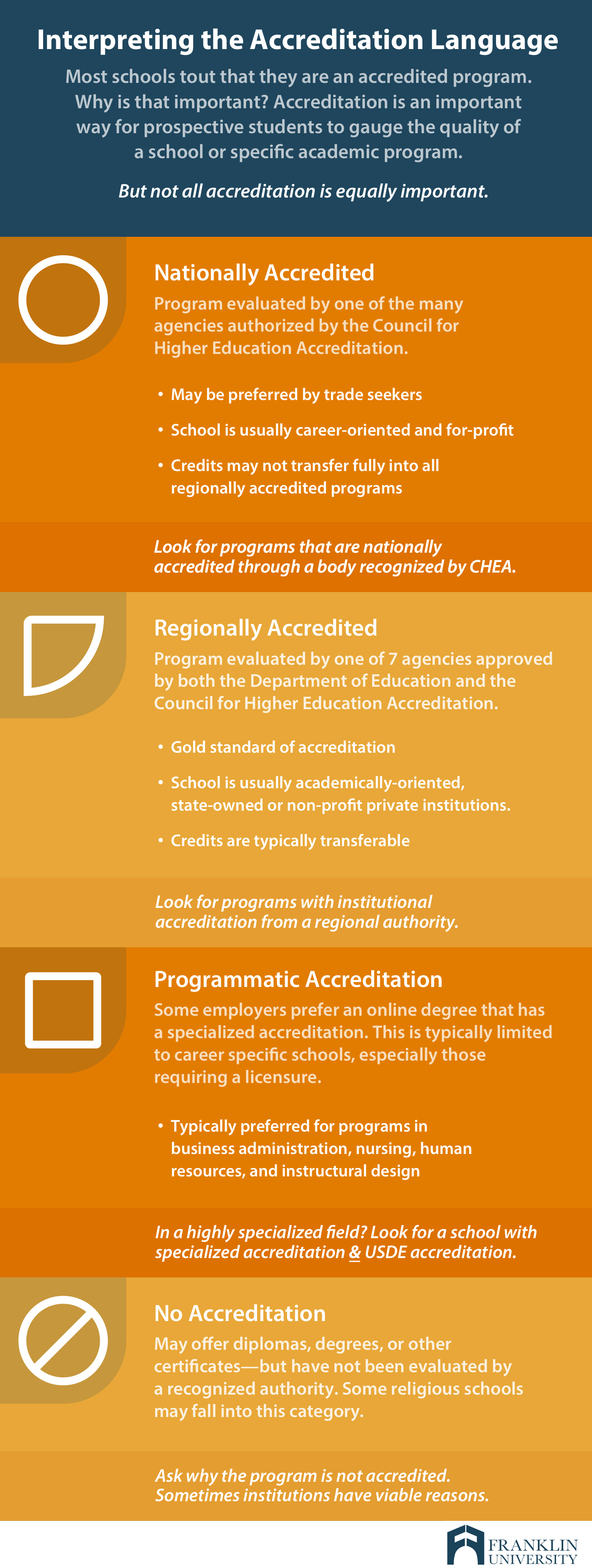Request Information
We're Sorry
There was an unexpected error with the form (your web browser was unable to retrieve some required data from our servers). This kind of error may occur if you have temporarily lost your internet connection. If you're able to verify that your internet connection is stable and the error persists, the Franklin University Help Desk is available to assist you at helpdesk@franklin.edu, 614.947.6682 (local), or 1.866.435.7006 (toll free).
Just a moment while we process your submission.

Do Community College Credits Transfer to a Four-Year Degree?
According to the National Center for Education Statistics (NCES), many community college credits are not following students when they seek a bachelor’s degree.
In fact, 67% of community college students experienced the transfer burn when enrolling for a bachelor’s degree.
On average, community college students lose about 13 credits following their first transfer. That’s nearly a whole semester of study. That’s precious time and money down the drain.
his begs the question: does it have to be this way?

Common Things That Affect Community College Credit Transferability
Many students use community college as a stepping stone to getting a bachelor’s degree. For some, the hope is to spend 1 or 2 years at the local level before transferring to a program to finish out in four years. Others may want to get an associate degree, use that knowledge to begin a career, and earn some money before they return to school to get a bachelor’s. Still others may think that an associate degree is all they want, only to change their minds later and decide to get their bachelor’s degree.
It seems pretty clear that some of their community college work should apply toward their bachelor’s. However, it’s not always that straightforward. Students may find themselves surprised when they go to transfer their credit. They may need to take additional courses to enroll, or retake courses they thought they’d already earned credit for, to earn their bachelor’s degree. Let's start by understanding what may commonly affect the transferability of community college hours.
Taking an A.A.S. Path
At community colleges, many programs are geared toward highly technical professions that involve a lot of hands-on training—for example, automotive technician, dental hygienist, electrician, paralegal, veterinary technician, registered nurse, or paramedic.
Typically, these programs require a fairly technical, highly specialized collection of coursework, and the degree awarded is an Associate of Applied Science degree, or A.A.S. Because the A.A.S. curricula are so specialized to one specific job, many four-year schools will not accept AAS coursework as transfer credit.
If your future plans include getting your bachelor’s degree, consider whether you might take a more general course of study toward an Associate of Science (A.S.) degree, which has more coursework that will transfer.
TIP:If you have an A.A.S., your hard work may not be lost. There are some schools that accept A.A.S. transfer credits. Ask your new school about which credits are relevant to the program you’re transferring into. At Franklin University, for example, it’s not just about the number of credits; it’s about how relatable your previous learning is to your new learning path. If at least 70 percent of the previous coursework applies, then it’s more likely that credit will transfer.
The Bachelor’s Transfer Acceptance Policy
Many 4-year colleges are not really focused on making credit transfer easy.
Others have special programs that make it much easier. In most cases, schools granting a 4-year degree will have a limit of the number of hours that can be transferred in. This limit is to ensure you reside or study a minimum amount of time at the new degree-granting school. sometimes this is called completing your "residency."
For example, some degree-granting schools require at least 30 hours of residency. So if you have a lot of hours to transfer, you may not be able to transfer any more than, say, 90 hours. That means your old 90 hours plus your new, required 30 hours will add up to the 120 you need for your degree.
As you seek answers, take a proactive approach by working directly with your new school's admission team. Don't forget to ask if some of your work experience might qualify as credit.
Lack of Accreditation
Accreditation ensures that employers and other schools will look at your degree as a true sign of your education and readiness.
Some community colleges and technical schools are non-accredited. That means the governing agencies that accredit schools feel their educational program isn’t up to the basic level of quality standards required for accreditation. Others are accredited by less-than-stellar entities. That’s how these schools can make their degrees fast to earn and relatively low in cost.

Very few schools will accept transfer credits from an unaccredited school, and many employers may not consider a degree from such a school to be valid. Getting a degree from an unaccredited school may seem like a good idea in the short-term, perhaps for building bridges into your local workforce. However, generally speaking, an unaccredited school will not be useful for transferring credit.
When it comes to paying for school, grants are among your best options. But do you know how to find them? Remove the guesswork by downloading this free guide.
What Can I Do To Get the Most Transfer Credit from My CC Work?
Whether you’ve already completed your community college coursework or just planning to enroll in community college, there are tips to help you maximize the amount of credits that you’ll transfer.
Already Complete Your Community College Work?
Will you be transferring community college credits so you can earn your degree? If so, you have some strategic options that can help.
- Ask the Community College for Articulation Agreements. Some schools have written agreements with a network of four-year schools. These agreements are called articulation agreements. "Articulation" in this case means comparing content of courses and the transfer of credit between different schools. An articulation guide offers a clear-cut picture of what will transfer among schools that are in the guide. Every year, these guides are updated, so as you consult them, be sure you're looking at the latest version.
- Look for Transfer-Friendly Bachelor’s Programs. When choosing your 4-year degree school, look for signs of a seamless transfer of associate degree classes. What do previous students say? Look at the school's website and read about their commitment to helping you with transfers. One important sign to look for, or ask about, is the size of the transfer network. A transfer-friendly school will have a large number of these agreements.
Plans like this can help you save up to half on your bachelor’s degree, while also ensuring no repeat classes, no re-learning, and no unnecessary expense.
Thinking About Enrolling in Community College?
Many students go into community college with the intent of transferring out to complete their degree. This is a way to save some money during the initial years. Here’s some advice to increase the likelihood of your credits transferring out.
- Choose a Well-Connected Community College. When choosing a community school, focus on programs that have relationships with other schools. Do they transfer credit? Do they have an articulation guide and written commitments? Talk with the admissions advisor and be clear in your plan to transfer.
- Find Creative Transfer Policies. Some programs offer creative solutions to maximize credits and to make transferring students feel welcomed. Franklin University, for example, has advisors who work exclusively with students transferring from specific community colleges. Franklin also offers an innovative 3+1 Program. Students in the program spend 3 years at a community college, earn their associate degree, and then transfer to Franklin where they get maximum credit toward a bachelor’s degree—while still meeting the 30-hour residency requirement.
- Seek Courses with Guaranteed Transfer. Some states have partnerships with all schools in the state with a guaranteed agreement to accept credits when the student transfers. In Ohio, there are Transfer Assurance Guides (or TAGs); the Ohio Higher Ed web page says, "All courses in TAGs are guaranteed to transfer and apply directly to the major requirements accordingly. Knowing in advance that the courses and programs taken at one of Ohio’s public institutions will transfer around the state gives students the flexibility of choosing lower-cost and more convenient options." The TAG transfer options work within all of Ohio’s 14 universities, 24 regional campuses and 23 community colleges. Perhaps a similar program exists in your state.
- Choose to pursue an A.S. path over A.A.S. If you select a highly specialized program of education, like respiratory technician, your resulting degree of Associate of Applied Science is likely to be laser-focused on just that job. In the future, your A.A.S. coursework will not likely qualify as transfer credit. Consider seeking an A.S. degree, with a more general course of study that can more easily be transferred in the future.
Think Beyond Transfer Credit to Fast-Track Your Bachelor’s
In addition to transferring credit, you have the chance to take tests to prove that you know your stuff. Testing can earn you credit, reduce your tuition costs, and shorten your path toward your bachelor’s. Some four-year degree programs are more likely than others to offer credit in exchange for testing. Before you decide on a school, it’s a good idea to find out how test-friendly their policies are.
Take Test Programs for Technical Areas
Depending on your school, you may be able to take test programs in a technical area. For example, maybe you went to technical school for heating and cooling management. But now you want to focus on owning your own business in heating and cooling, so you want an applied management business degree. Work with your school to see if they will guide you toward testing that gains you credits toward your degree.
Take CLEP/DSST Tests
Talk with your admissions advisor and discover if you can test out of some credits. Several approved testing agencies, including CLEP and DSST (link both) can, for a fee of about $100, test your knowledge and grant you credit if you pass.
Keep an Open Mind: There Are Reputable Options Out There!
When you're a college student just trying to earn a degree, nothing's worse than wasted work and time. And that's what you get when community college credits don't transfer from your old school to your new one.
It pays big to research.
As you research schools that grant four-year degrees, you will occasionally run across a program that seems tailored for your needs. Maybe it's a curriculum that has fewer hours to earn toward a degree. It could be an admissions officer that goes above and beyond to make you feel welcomed. Maybe it's an app or an online schedule that sounds like a fit. Keep a careful and comparative watch; competitive schools are keen to provide you with creative options related to credit transfer.
Some degree-granting schools are using online tools and mobile access so you can quickly see how much of your work may transfer to Franklin.
In the end, most students generally know when they’ve found a school that respects their previous knowledge and truly gives them the credit they deserve.





